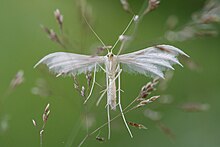Pterophorus pentadactyla
| Pterophorus pentadactyla | ||||||||||||
|---|---|---|---|---|---|---|---|---|---|---|---|---|

Pterophorus pentadactyla |
||||||||||||
| Systematics | ||||||||||||
|
||||||||||||
| Scientific name | ||||||||||||
| Pterophorus pentadactyla | ||||||||||||
| ( Linnaeus , 1758) |
Pterophorus pentadactyla (White Morning Glory pterophoridae) is in almost all of Europe occurring kind from the family of pterophoridae (Pterophoridae). The (wrong) German name Schlehen-Federgeistchen implies that sloes play an important role within the food spectrum of this species, but this is not correct.
features
Pterophorus pentadactyla has a white basic color and reaches a wingspan of 24 to 35 millimeters. The butterfly is one of the largest representatives within the genus Pterophorus . The wings are speckled with some dark scales . The deep, finger-shaped split wings, which also appear feather-like and fringed, are striking. The forewings are split two, the hind wings threefold. The species also has "spurs" on its legs; the hind legs are very long.
The caterpillars are pale green in color and have long white hairs, especially on the front and rear ends. They reach a length of about twelve millimeters. There is a white, yellow dotted line on the back, and brownish hairs arise from the back warts.
The pupae are greenish or dirty white in color, are very slender and have long white bristles on the warts.
Similar species
The caterpillars of Emmelina monodactyla are often found associated with those of Pterophorus pentadactyla , but these have a broad, dark topline and are noticeably shorter with hair.
distribution
Pterophorus pentadactyla is widespread in Europe , with the exception of the extreme south. In the east the distribution area extends over Asia Minor to Iran . The moths are often found in areas rich in grass with bushes, in fields, in gardens and on ruderal sites .
Way of life
The white eggs are laid by the females individually or in small groups on the leaves of the food plants. The larvae are initially found on the undersides of young leaves of their food plants, which include bindweed ( Convolvulus arvensis ) and bindweed ( Calystegia sepium ). According to other information, clover ( Trifolium ) as well as buckthorn ( Rhamnus ), roses ( Rosa ), willows ( Salix ) and blackthorn ( Prunus spinosa ) should also belong to the food spectrum. Brown spots appear on the gnawed leaves. Later, the caterpillars also feed on the upper side of the leaf as well as on the flower buds and flowers. The caterpillars rest either on the underside of the leaves or on stems. Some of the caterpillars grow up quickly and pupate in summer, so that a second generation emerges in August. The slower growing caterpillars overwinter and continue their development in the next spring. The pupation also takes place on the underside of leaves, while the doll is attached to the rear end on a small web pads. During the day, the moths are usually found resting in the herb layer , while they sit on the first two pairs of legs, the last pair is stretched backwards and lies against the body. The hind wings are pushed under the forewings. The moths are crepuscular and nocturnal and are attracted by light at night.
Flight time
A generation is formed and it flies from May to September. Under favorable conditions, a second (incomplete) generation can arise in August.
Systematics
Synonyms
The following synonyms have been described in the literature:
- Phalaena Alucita pentadactyla Linnaeus, 1758
- Phalaena tridactyla Scopoli, 1763
- Alucita pentadactyla Denis & Schiffermüller, 1775
- Alucita pentadactyla Huebner, [1805]
- Aciptilia pentadactyla var.sulphurea Staudinger, 1880
Individual evidence
- ↑ a b c C. Gielis: Pterophoridae. In: P. Huemer, O. Karsholt, L. Lyneborg (Eds.): Microlepidoptera of Europe 1: 1-222. , Apollo Books 1996, ISBN 87-88757-36-6
- ↑ a b Heiko Bellmann : The new Kosmos butterfly guide. Butterflies, caterpillars and forage plants. Franckh-Kosmos, Stuttgart 2003, ISBN 3-440-09330-1 .
- ↑ Jozef Ponec: Butterflies of our homeland. Verlag Obzor, Bratislava (German translation of the original Slovak edition from 1982), ISBN 3-8112-0380-0
- ↑ Thomas Kaltenbach, Peter Victor Küppers: Kleinschmetterlinge. Verlag J. Neudamm-Neudamm, Melsungen 1987, ISBN 3-7888-0510-2
- ↑ C. Gielis: Pterophoroidea & Alucitoidea. In: World Catalog of Insects. Volume 4 , Apollo Books, 2003, ISBN 87-88757-68-4
Web links
- www.lepiforum.de
- Markku Savela: Lepidoptera and some other life forms (English)
- Guide to the moths of Great Britain and Ireland (English)
- Pterophorus pentadactyla at Fauna Europaea


